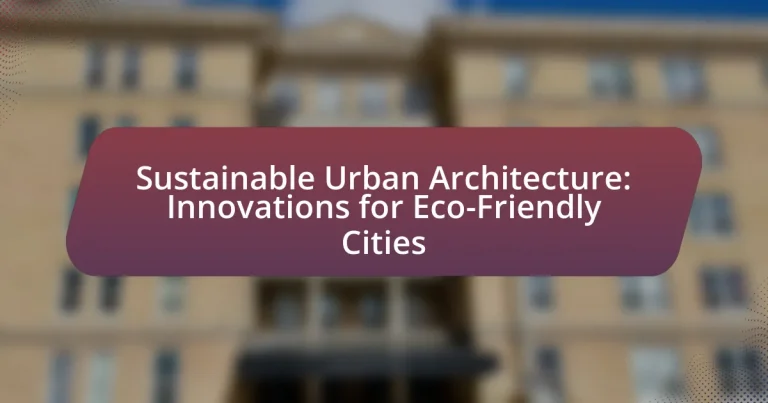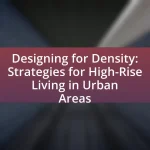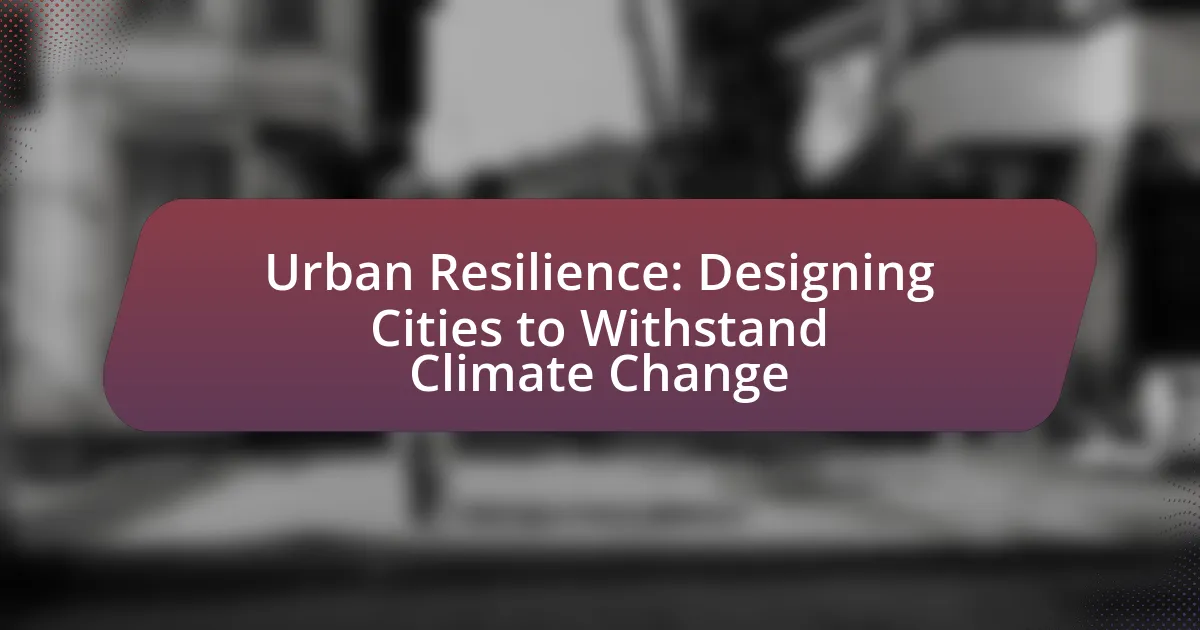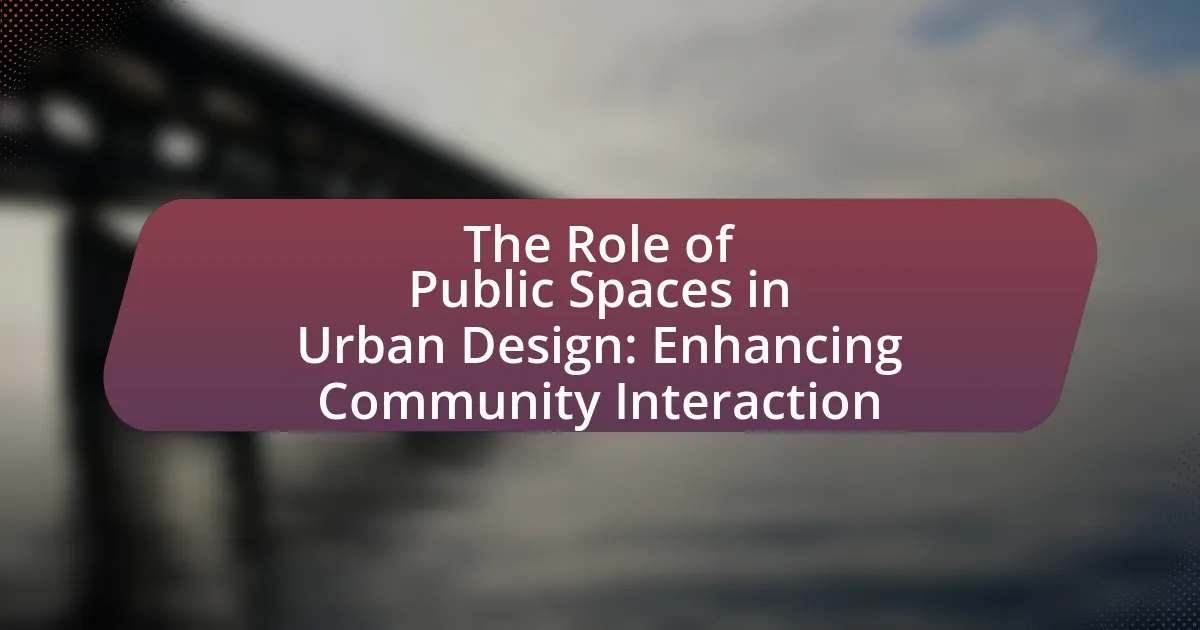Sustainable urban architecture is a design approach that emphasizes environmental responsibility, resource efficiency, and social equity in urban development. This article explores how sustainable architecture contributes to eco-friendly cities by integrating energy-efficient systems, renewable energy sources, and green spaces, thereby reducing carbon footprints and enhancing residents’ quality of life. Key principles include energy efficiency, resource conservation, and social equity, while innovations such as smart technologies and the use of recycled materials play a crucial role in promoting sustainability. The article also addresses the challenges cities face without sustainable practices and highlights successful examples and leading cities in sustainable urban design initiatives.

What is Sustainable Urban Architecture?
Sustainable urban architecture is a design approach that prioritizes environmental responsibility, resource efficiency, and social equity in urban development. This architectural practice integrates sustainable materials, energy-efficient systems, and green spaces to minimize ecological impact while enhancing the quality of life for residents. For instance, buildings designed with passive solar heating and natural ventilation can significantly reduce energy consumption, aligning with the principles of sustainability. According to the United Nations, urban areas account for approximately 70% of global carbon emissions, highlighting the urgent need for sustainable practices in architecture to combat climate change and promote healthier urban environments.
How does Sustainable Urban Architecture contribute to eco-friendly cities?
Sustainable Urban Architecture contributes to eco-friendly cities by integrating environmentally responsible design principles that reduce resource consumption and minimize ecological impact. This architectural approach emphasizes energy efficiency, utilizing renewable energy sources, and incorporating green spaces, which collectively lower carbon footprints. For instance, buildings designed with passive solar heating can reduce energy use by up to 50%, as reported by the U.S. Department of Energy. Additionally, the use of sustainable materials, such as recycled steel and bamboo, further decreases environmental degradation. By promoting efficient water management systems, such as rainwater harvesting, sustainable urban architecture enhances urban resilience against climate change.
What are the key principles of Sustainable Urban Architecture?
The key principles of Sustainable Urban Architecture include energy efficiency, resource conservation, and social equity. Energy efficiency focuses on minimizing energy consumption through design strategies such as passive solar heating, natural ventilation, and high-performance insulation. Resource conservation emphasizes the use of sustainable materials, waste reduction, and water management techniques, such as rainwater harvesting and greywater recycling. Social equity ensures that urban spaces are accessible and inclusive, promoting community engagement and affordable housing. These principles are supported by various studies, such as the “Sustainable Urban Development” report by the United Nations, which highlights the importance of integrating environmental, economic, and social factors in urban planning.
How does design impact sustainability in urban settings?
Design significantly impacts sustainability in urban settings by influencing resource efficiency, energy consumption, and waste management. Sustainable design practices, such as incorporating green roofs, energy-efficient buildings, and sustainable materials, reduce the ecological footprint of urban areas. For instance, a study by the American Institute of Architects found that buildings designed with sustainability in mind can reduce energy use by up to 50%. Additionally, urban design that prioritizes walkability and public transportation can decrease reliance on cars, thereby lowering greenhouse gas emissions. These design strategies not only enhance the livability of cities but also contribute to long-term environmental health.
Why is Sustainable Urban Architecture important for urban development?
Sustainable Urban Architecture is crucial for urban development because it promotes environmental stewardship, enhances quality of life, and fosters economic viability. By integrating green building practices, such as energy efficiency and sustainable materials, cities can reduce their carbon footprint and resource consumption. For instance, buildings designed with sustainable principles can lower energy use by up to 50%, as demonstrated by the U.S. Green Building Council’s LEED certification program. This approach not only mitigates climate change impacts but also creates healthier living environments, which can lead to increased property values and economic growth.
What challenges do cities face without sustainable architecture?
Cities face significant challenges without sustainable architecture, including increased environmental degradation, higher energy consumption, and greater social inequality. The absence of sustainable design leads to inefficient resource use, contributing to pollution and climate change. For instance, buildings account for approximately 40% of global energy consumption and 30% of greenhouse gas emissions, as reported by the International Energy Agency. Additionally, cities lacking sustainable infrastructure often experience exacerbated urban heat islands, which can increase energy demand for cooling and negatively impact public health. Furthermore, without sustainable practices, low-income communities may suffer disproportionately from inadequate housing and limited access to green spaces, leading to social disparities.
How can Sustainable Urban Architecture improve quality of life?
Sustainable urban architecture improves quality of life by creating environments that enhance health, well-being, and community engagement. This architectural approach incorporates green spaces, energy-efficient buildings, and sustainable materials, which contribute to reduced pollution and improved air quality. For instance, studies show that access to green spaces can lower stress levels and promote physical activity, leading to better mental and physical health outcomes. Additionally, sustainable urban designs often prioritize walkability and public transportation, reducing reliance on cars and fostering social interactions among residents. Research from the American Institute of Architects indicates that well-designed urban spaces can increase community cohesion and overall satisfaction with living conditions.

What innovations are shaping Sustainable Urban Architecture?
Innovations shaping Sustainable Urban Architecture include green building materials, energy-efficient designs, and smart technology integration. Green building materials, such as recycled steel and bamboo, reduce environmental impact and enhance sustainability. Energy-efficient designs, like passive solar heating and natural ventilation, minimize energy consumption, with studies showing that buildings designed with these principles can reduce energy use by up to 50%. Smart technology integration, including IoT devices for energy management, optimizes resource use and improves building performance. These innovations collectively contribute to creating eco-friendly urban environments.
How are new materials influencing eco-friendly building practices?
New materials are significantly influencing eco-friendly building practices by enhancing energy efficiency, reducing waste, and promoting sustainability. For instance, materials such as cross-laminated timber and recycled steel are being utilized for their lower carbon footprints compared to traditional materials like concrete and virgin timber. According to a study by the University of Cambridge, using cross-laminated timber can reduce greenhouse gas emissions by up to 75% compared to concrete. Additionally, innovations like bio-based materials, which include hempcrete and mycelium, are gaining traction for their ability to sequester carbon and improve indoor air quality. These advancements not only contribute to sustainable construction but also align with global efforts to mitigate climate change impacts.
What are the benefits of using recycled materials in construction?
Using recycled materials in construction significantly reduces environmental impact by minimizing waste and conserving natural resources. Recycled materials, such as reclaimed wood, recycled steel, and repurposed concrete, divert waste from landfills, which accounted for approximately 25% of total waste in the United States in 2018, according to the Environmental Protection Agency. Additionally, utilizing these materials lowers energy consumption during production, as recycling often requires less energy than creating new materials. For instance, recycling aluminum saves about 90% of the energy needed to produce new aluminum from raw materials. Furthermore, incorporating recycled materials can lead to cost savings in construction projects, as they are often less expensive than new materials. Overall, the use of recycled materials promotes sustainability, reduces carbon footprints, and supports the circular economy in the construction industry.
How do smart technologies enhance sustainability in urban architecture?
Smart technologies enhance sustainability in urban architecture by optimizing resource use and improving energy efficiency. For instance, smart sensors and IoT devices monitor energy consumption in real-time, allowing buildings to adjust heating, cooling, and lighting based on occupancy and weather conditions. This leads to a reduction in energy waste; studies show that smart building technologies can reduce energy consumption by up to 30%. Additionally, smart technologies facilitate the integration of renewable energy sources, such as solar panels, into urban designs, further decreasing reliance on fossil fuels. The implementation of these technologies not only minimizes environmental impact but also promotes sustainable urban living by enhancing the overall quality of life for residents.
What role does renewable energy play in Sustainable Urban Architecture?
Renewable energy is essential in Sustainable Urban Architecture as it significantly reduces carbon emissions and enhances energy efficiency. By integrating solar panels, wind turbines, and geothermal systems into building designs, urban areas can generate clean energy, thereby minimizing reliance on fossil fuels. For instance, buildings designed with photovoltaic systems can produce up to 80% of their energy needs from renewable sources, leading to a substantial decrease in greenhouse gas emissions. Furthermore, the use of renewable energy contributes to the resilience of urban infrastructure, allowing cities to adapt to climate change impacts while promoting sustainable living practices.
How can solar energy be integrated into urban designs?
Solar energy can be integrated into urban designs through the incorporation of photovoltaic panels on rooftops, building facades, and public spaces. This approach not only generates renewable energy but also enhances the aesthetic appeal of urban environments. For instance, cities like San Diego have implemented solar panel installations on municipal buildings, resulting in a 30% reduction in energy costs. Additionally, solar energy can be utilized in urban planning by designing solar parks and integrating solar trees in public areas, which provide shade while generating electricity. These strategies contribute to sustainable urban architecture by reducing reliance on fossil fuels and promoting eco-friendly practices.
What are the advantages of green roofs and walls?
Green roofs and walls provide multiple advantages, including improved energy efficiency, enhanced biodiversity, and stormwater management. These systems reduce heat absorption, leading to lower energy costs for heating and cooling buildings, with studies indicating a potential reduction in energy use by up to 75% in some cases. Additionally, green roofs and walls support various plant species, promoting urban biodiversity and providing habitats for wildlife. They also effectively manage stormwater by absorbing rainwater, which can reduce runoff by up to 50%, thereby mitigating flooding and water pollution.

What are the best practices for implementing Sustainable Urban Architecture?
The best practices for implementing Sustainable Urban Architecture include integrating renewable energy sources, utilizing sustainable materials, and promoting efficient land use. Integrating renewable energy, such as solar panels and wind turbines, reduces reliance on fossil fuels and lowers greenhouse gas emissions. Utilizing sustainable materials, like recycled steel and bamboo, minimizes environmental impact and promotes resource conservation. Efficient land use, through mixed-use developments and green spaces, enhances urban livability and reduces urban sprawl. These practices are supported by studies indicating that cities adopting sustainable architecture can reduce energy consumption by up to 50% and improve air quality significantly.
How can urban planners incorporate sustainability into their projects?
Urban planners can incorporate sustainability into their projects by integrating green building practices, promoting mixed-use developments, and enhancing public transportation systems. Green building practices, such as using energy-efficient materials and renewable energy sources, reduce environmental impact and improve resource efficiency. Mixed-use developments encourage walkability and reduce reliance on cars, which lowers carbon emissions. Additionally, enhancing public transportation systems increases accessibility and decreases traffic congestion, further contributing to sustainable urban environments. According to the U.S. Green Building Council, buildings that meet green standards can reduce energy consumption by up to 30%, demonstrating the effectiveness of these strategies in promoting sustainability.
What strategies can be used to engage communities in sustainable design?
To engage communities in sustainable design, strategies such as participatory design processes, educational workshops, and collaborative projects can be implemented. Participatory design processes involve community members in the planning and decision-making stages, ensuring their needs and preferences are considered, which has been shown to increase community buy-in and satisfaction with the outcomes. Educational workshops raise awareness about sustainability issues and empower residents with knowledge and skills to contribute to sustainable practices. Collaborative projects, such as community gardens or green infrastructure initiatives, foster a sense of ownership and responsibility among participants, leading to long-term commitment to sustainable design principles. These strategies have been supported by studies indicating that community involvement significantly enhances the effectiveness and acceptance of sustainable design initiatives.
How can policies support the development of eco-friendly cities?
Policies can support the development of eco-friendly cities by implementing regulations that promote sustainable practices and incentivize green technologies. For instance, policies can mandate energy-efficient building codes, which have been shown to reduce energy consumption by up to 30% in new constructions. Additionally, governments can provide tax incentives for renewable energy installations, encouraging the adoption of solar panels and wind turbines. Research from the International Energy Agency indicates that such policies can lead to a significant decrease in greenhouse gas emissions, contributing to a healthier urban environment. Furthermore, urban planning policies that prioritize public transportation and green spaces can enhance air quality and improve residents’ quality of life, as evidenced by studies linking urban greenery to reduced urban heat islands and improved mental health outcomes.
What are some successful examples of Sustainable Urban Architecture?
Some successful examples of Sustainable Urban Architecture include the Bosco Verticale in Milan, Italy, and the One Central Park in Sydney, Australia. Bosco Verticale, designed by Stefano Boeri, features residential towers with over 9,000 trees and 20,000 plants, significantly improving air quality and biodiversity in the urban environment. One Central Park, designed by architect Frank Gehry, incorporates green roofs and vertical gardens, promoting energy efficiency and reducing urban heat. Both projects exemplify how integrating nature into urban design can lead to sustainable living spaces that enhance the quality of life for residents while addressing environmental challenges.
Which cities are leading in sustainable urban design initiatives?
Copenhagen, Amsterdam, and Singapore are leading in sustainable urban design initiatives. Copenhagen aims to become the world’s first carbon-neutral city by 2025, implementing extensive cycling infrastructure and green roofs. Amsterdam is renowned for its innovative water management systems and energy-efficient buildings, contributing to its status as a model for sustainable urban living. Singapore integrates nature into its urban landscape through vertical gardens and extensive park systems, promoting biodiversity and reducing urban heat. These cities exemplify effective strategies in sustainable urban design, supported by their respective government policies and community engagement efforts.
What lessons can be learned from these successful projects?
Successful projects in sustainable urban architecture demonstrate the importance of integrating eco-friendly materials and technologies. These projects highlight that utilizing renewable resources, such as solar panels and green roofs, significantly reduces energy consumption and enhances urban biodiversity. For instance, the Bosco Verticale in Milan, which incorporates vertical gardens, has shown a 30% reduction in energy use for heating and cooling, proving that innovative design can lead to substantial environmental benefits. Additionally, community engagement in the planning process fosters a sense of ownership and ensures that developments meet local needs, as seen in the participatory design approach of the Eco-City project in Tianjin, China. This involvement leads to more sustainable and accepted urban solutions.
What practical steps can individuals take to promote Sustainable Urban Architecture?
Individuals can promote Sustainable Urban Architecture by adopting eco-friendly practices in their daily lives and advocating for sustainable policies. For instance, individuals can reduce energy consumption by using energy-efficient appliances and supporting renewable energy sources, which contributes to lower carbon emissions. Additionally, participating in community initiatives, such as tree planting and urban gardening, enhances green spaces and biodiversity in urban areas. Supporting local businesses that prioritize sustainable materials and practices also fosters a circular economy. Furthermore, individuals can engage in advocacy for policies that promote sustainable building codes and urban planning, which can lead to more environmentally friendly developments. These actions collectively contribute to the advancement of sustainable urban architecture, as evidenced by studies showing that community involvement and policy advocacy significantly impact urban sustainability outcomes.





